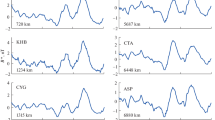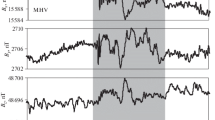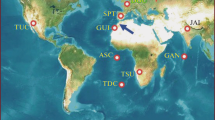Abstract
In this work, we attempt to quantify forces that result from the interaction between the induced Sq-variation currents in the Earth’s lithosphere and the regional Earth’s magnetic field, in order to assess its influence on the tectonic stress field and on seismic activity. The study area is the Sinai Peninsula, a seismically active region where both seismic and magnetic data are available. We show that both short-term and long-term magnetic changes correlate with the seismic activity extending to this area in other previous studies. We also analyze a set of large earthquakes and magnetic data from observatories around the world to deduce a relationship between earthquake magnitude and maximum distance up to which precursory variations of the magnetic field are observed.















Similar content being viewed by others
References
Ben-Menahem A, Nur A, Vered M (1976) Tectonics, seismicity and structure of the Afro-Eurasian junction—the breaking of an incoherent plate. Phys Earth Planet Inter 12:1–50
Chapman S, Bartels J (1940) Geomagnetism. Oxford University Press (Clarendon), London and New York
Chen YI, Chuo JY, Liu JY, Pulinets SA (1999) Statistical study of ionospheric precursors of strong earthquakes at Taiwan area, XXVI URSI General Assembly, Toronto, 13–21 August 1999. Abstracts, p 745
Ding J, Liu J, Yu S, Xiao W (2004) Geomagnetic diurnal-variation anomalies and their relation to strong earthquakes. Acta Seismologica Sin 17(Suppl):85–93
Duma G (1996) Seismicity and the Earth’s magnetic field a clear relation demonstrated for several seismic regions, XXV General Assembly of the European Seismological Commission ESC, Reykjavik, Island, 1996, Icelandic Meteorological Office (Abstracts)
Duma G (1999) Regional geomagnetic variations and temporal changes of seismic activity: observations of a so far unknown phenomenon, attempts of interpretation, 22nd general assembly of IUGG, Birmingham, England, Session JSA15 (Abstract)
Duma G (2005) A significant electromagnetic process controls earthquake activity. Geophys Res Abstr 7:02860
Duma G, Ruzhin Y (2003) Diurnal changes of earthquake activity and geomagnetic Sq-variations. Nat Hazards Earth Syst Sci 3:171–177
Freund F (2000) Time-resolved study of charge generation and propagation in igneous rocks. J Geophys Res 105:11001–11019
Freund FT (2007) Pre-earthquake signals—part I: deviatoric stresses turn rocks into a source of electric currents. Nat Hazards Earth Syst Sci 7:535–541
Freund F, Sornette D (2007) Electro-magnetic earthquake bursts and critical rupture of peroxy bond networks in rocks. APS preprint
Gauss CF (1839) Allgemeine Theorie des Erdmagnetismus. Resultate aus den Beobachtungen des magnetischen Vereins im Jahre 1838, Leipzig. Reprinted In: Gauss CF (ed) 1877. Werke, vol 5, pp 119–193. Königlichen Gesellshaft der Wissenschaften, Göttingen
Honkura Y (1985) Some results from measurements of the geomagnetic field and the electrical resistivity in the Izu-Tokai region, Japan. In: Kisslinger L, Rikitake T (eds) Practical approaches to earthquake prediction and warning, pp 365–378
Jackson JA, White NJ, Garfunkel Z, Anderson H (1988) Relations between normal-fault geometry, tilting and vertical motions in extensional terrains: an example from the southern Gulf of Suez. J Struct Geol 10(2):155–170
Johnston MJS, Sasai Y, Egbert GD, Mueller RJ (2006) Seismomagnetic effects from the long-awaited 28 September 2004 M 6.0 Parkfield earthquake. Bul Seism Soc Am 96:206–220
Kamogawa M (2006) Preseismic lithosphere-atmosphere-ionosphere coupling. Eos vol 87, No. 40, 3 October 2006
Le Pichon X, Gaulier J-M (1988) The rotation of Arabia and the levant fault system. Tectonophysics 153:271–294
Liu JY, Chen YI, Pulinets SA, Tsai YB, Chuo YJ (2000) Seismo-ionospheric signatures prior to M ≥ 6.0 Taiwan earthquakes. Geophys Res Lett 27:3113–3116
Liu JY, Chuo YJ, Shan SJ, Tsai YB, Chen YI, Pulinets SA, Yu SB (2004) Pre-earthquake ionospheric anomalies registered by continuous GPS TEC measurements. Ann Geophys 22:1585–1593
Mandea M, Macmillan S, Bondar T, Golokov V, Langlais B, Lowes F, Olsen N, Quinn J, Sabaka T (2000) International geomagnetic reference field 2000. Phys Earth Planet Inter 120:39–42 Also in Pure and Applied Geophysics, vol 157, pp 1797–1802
Naaman SH, Alperovich LS, Wdowinski Sh, Hayakawa M, Calais E (2001) Comparison of simultaneous variations of the ionospheric total electron content and geomagnetic field associated with strong earthquakes. Nat Hazards Earth Syst Sci 1:53–59
Nagata T (1976) Seismo-magnetic effect in a possible association with the Niigata earthquake in 1964. J Geomag Geoelectr 28:99–111
Pulinets SA, Alekseev VA, Boyarchuk KA, Hegai VV, Depuev VKh (1999) Radon and ionosphere monitoring as a means for strong earthquakes forecast. Il Nuovo Cimento 22C(N3–4):621–626
Russell HD (2002) The earth’s magnetic field is still losing energy. Creat Res Soc Q 39:1–11
Said R (1990) The geology of Egypt. Elsevier, Amsterdam
Sasai Y (1980) Application of the elasticity theory of dislocations to tectonomagnetic modeling. Bul Earthq Res Ins 55:387–447
Sasai Y (1983) A surface integral representation of the tectonomagnetic field based on the linear piezomagnetic effect. Bul Earthq Res Ins 58:763–785
Smirnova N, Hayakawa M, Gotoh K, Volobuev D (2001) Scaling characteristics of ULF geomagnetic fields at the Guam seismoactive area and their dynamics in relation to the earthquake. Nat Hazards Earth Syst Sci 1:119–126
Smith BE, Johnston MJS (1976) A tectonomagnetic effect observed before a magnitude 5.2 earthquake near Hollister California. J Geophys Res 81:3556–3560
Sobolev G, Zakrzhevskaya N (2003) Magnetic storm influence on seismicity in different regions. Geophys Res Abstr 5:00135
Tzanis A (2003) Can earthquakes be trigged by diurnal geomagnetic variations? Observational evidence from Greece and abroad. Geophys Res Abstr 5:13108
Xue S-X (1989) The evaluation of earthquake prediction ability [A]. In: Department of science, technology and monitoring, State Seismological Bureau (ed) The practical research papers on Earthquake prediction methods (seismicity section) [C]. Seismological Press, Beijing, pp 586–589 (in Chinese)
Yamazaki Y, Rikitake T (1970) Local anomalous changes in the geomagnetic field at Matsushiro. Bull Earthq Res Inst Univ Tokyo 48:637–643
Yen H-Y, Chen C-H, Yeh Y-H, Liu J-Y, Lin C-R, Tsai Y-B (2004) Geomagnetic fluctuations during the 1999 Chi-Chi earthquake in Taiwan. Earth Planets Space 56:39–45
Zhu FM (1976) Prediction, warning, and disaster prevention to the Haicheng earthquake of magnitude 7.3. Proceedings of Lectures by the seismological delegation of the People’s Republic of China, Seismol. Society of Japan Special Publication, pp 15–26 (in Japanese)
Acknowledgments
The Authors deeply thank Professor Mioara Mandea (Professor of geomagnetism at IPGP and Potsdam) for her great efforts to revise the part of this work on magnetic variations. Also, we thank Dr. Gerald Duma (Professor of geophysics at ZAMG) for his efforts to revise the manuscript especially the seismic and magnetic variations.
Author information
Authors and Affiliations
Corresponding author
Rights and permissions
About this article
Cite this article
Rabeh, T., Miranda, M. & Hvozdara, M. Strong earthquakes associated with high amplitude daily geomagnetic variations. Nat Hazards 53, 561–574 (2010). https://doi.org/10.1007/s11069-009-9449-1
Received:
Accepted:
Published:
Issue Date:
DOI: https://doi.org/10.1007/s11069-009-9449-1




